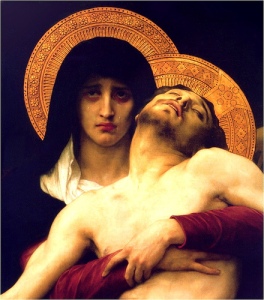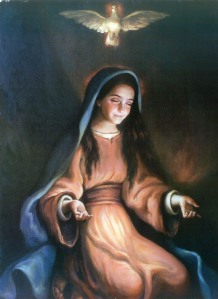In her new autobiography, The Ear of the Heart: An Actress’ Journey from Hollywood to Holy Vows, Mother Dolores Hart, O. S. B. spoke about her name. Dolores is derived from the Latin Mater Dolorosa or Sorrowful Mother, a common title of the Blessed Virgin Mary. Mother Dolores had her own share of sorrows throughout her life. For this reason, she said that because of all the sorrows that she has seen, a “Dolores” must be a listener, a person who is able to identify with the sorrows of others.
Does this sound familiar? Good.
In the movie The Passion of the Christ, Christ’s final hours on earth are depicted with the utmost realism and artistry. We see not only the events of the Passion as they unfold from Jesus’ point of view, but also from the perspectives of St. Peter, St. John, and St. Mary Magdalene. But some of the most poignant scenes are those that show the proceedings from the perspective of the Blessed Virgin Mary.
Why? Maybe because they are supposed to be. The movie depicts acts of unspeakable violence that can become unbearable to watch. If the movie was composed simply of shot after shot of the violence heaped upon Christ, it probably would be unbearable to watch. But that is not how the movie plays out. Instead, we see flashbacks to earlier events in Christ’s life, reminding us that He is now practicing what He preached. We see the reactions of his disciples to this brutality: their horror, their fear, and their sorrow. And somehow, it makes the movie easier to watch.
By seeing how Jesus’ disciples reacted to the Passion, we see how we should react. We realize that there are people other than the people who were persecuting Christ and who are able to see the horror of what was happening. Foremost among Christ’s disciples in feeling this horror is His own Blessed Mother. And it isn’t difficult to imagine the heartbreak felt by any mother to see her child treated so shamefully. By putting ourselves in her place, we are able to understand her pain. And perhaps that is one reason why these scenes from the movie are so poignant.

But Mary’s sorrow runs deeper than that. While she does weep and we see the sadness in her eyes, something greater is happening inside of her. She is trying to make sense of what is happening. Mary knows that her Son is God and is waiting for Him to be delivered from His captors, as she says during His scourging. When she finally meets Him on the road to Golgotha, He says, “Behold, Mother, I make all things new.” At this point, Mary realizes that there is a light at the end of the tunnel, even if she doesn’t understand it perfectly—that a greater good will come out of this evil, and she lets go of her fear.
Now this movie is by no means a definitive guide to how the Blessed Virgin Mary acted and what she said during the Passion. But it gives us an idea of how she might have acted. It is doing the same thing that Christians do when they pray the Rosary or the Way of the Cross. They are asking Mary to be their guide and following her through the events of Christ’s life.
Mary is a guide, but an unusual guide because at the same time, she is also a pilgrim.
But why would anyone choose her, of all people, to be a guide? After all, she only speaks seven times in all of Sacred Scripture. However, those seven times speak volumes about Mary. For one thing, it confirms what Mother Dolores Hart said that a “Dolores”—Mater Dolorosa (a. k. a. Mary)—must be a listener. Maybe it is Mary’s participation in the Passion makes this most apparent because while Mary is said to be present at her Son’s Crucifixion, she doesn’t say anything. Rather, Jesus speaks to her: “Woman, behold, your son!” And He tells His disciple about His mother: “Behold, your mother!” (cf. John 19:26-27). Jesus Himself points to His mother as a mother to us and what better guide than a mother? Mary is silent throughout John’s account of the Passion, but of course she participates in her Son’s pain. So go to her, she will listen to you. She is able to identify with your pain, too.
Jesus is both pilgrim and guide, too. He both gives advice on how to navigate the pilgrimage of life and also navigates it as a pilgrim Himself, to its lowest depths, practicing exactly what He preached. Jesus is our pilgrim and guide and could be called THE Pilgrim and Guide.
Why am I focusing on Mary, rather than Him? Because, in the midst of our fallen human nature, we need more than one example to follow. Sometimes, we find ourselves saying, “Jesus is God! Of course, He would follow His Father’s Will.” Sometimes, we need to see what someone following Jesus would do. And Jesus Himself points to her, as I said above, and when He says that the person who does the will of God is His mother (cf. Mark 3:35). Mary is not a guide at the exclusion of Jesus, but a guide TO Jesus!

The Blessed Virgin Mary is Jesus’ first disciple and the one who followed Him perfectly. She shows us exactly what it means to be a follower of Jesus, more because of what she does than what she says. Like Harry Potter and Dante, she listens to her guide. Sometimes she doesn’t understand what her guides are saying, but she ponders it in her heart (cf. Luke 2:19).
We discover that what Mary says is always illuminated by her actions. Her “yes” to God is more than that moment when she says it, but is lived every moment of her life. When she receives praise, she gives the glory to God (cf. Luke 1: 46) and we don’t ever see her chasing after her own glory. She tells the stewards at the wedding to do whatever Jesus tells them (cf. John 2:5) and does the same herself. And she follows Jesus even to the Cross.
But unlike Harry Potter or Dante, she is a real, living person. She has actually survived a pilgrimage on earth and now lives forever with her Son in Heaven. Her story is not just an ideal, but the truth. We see that Mary could follow God’s Will perfectly and are even more reassured that we can follow God’s Will, too.
And instead of being simply a pilgrim that we read about in a book, she is available to be a guide for each of us on our own pilgrimage. We need only ask.
